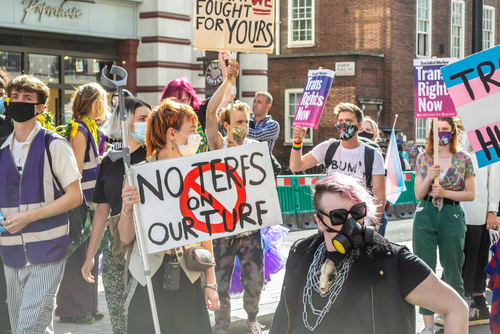What Is a TERF?

Writer J.K. Rowling, author of the Harry Potter books, came under fire multiple times in recent years for making transphobic comments. She publicly expressed support in 2019 for Maya Forstater, a British woman whose contract was not renewed because of her comments on transgender people. The following year, Rowling tweeted criticism of an article that used inclusive language discussing menstruation. Per the author, the phrase “people who menstruate” was erasing women. Several of Rowling’s detractors have called her a TERF. Let’s take a closer look at this term and what it means.
What’s a TERF?
TERF is an acronym coined in 2008 which stands for trans-exclusionary radical feminist. This term originally applied to a small group of feminists who held one or more of the following views:
- Trans women aren’t women.
- Spaces for women should not include trans women.
- Fighting for transgender rights is not a feminist cause.
Viv Smythe, a trans-inclusive, radical feminist blogger, is credited with popularizing the term in a post criticizing the Michigan Women’s Music Festival’s rule of not admitting trans women. According to Smythe, TERF was supposed to be a neutral description of a minority of radical feminists who rejected trans women as their sisters. Today, the acronym is often used for anyone with trans-exclusionary views, regardless of their affiliation or belief in radical feminism.
Is TERF an Offensive Word?
People who are called TERFs generally object to the term and consider themselves to be gender-critical instead. Some claim that they cannot be called trans-exclusionary because they include trans men (who were born with female reproductive parts) with women. Others think of TERF as a bullying insult, intended to repress dialogue and further research. Some critics also believe the term encourages violence against women, citing online spaces where trolls post phrases such as “punch a TERF!”
What’s Wrong With Being Gender-Critical?
While the word TERF was coined online in the 2000s, the exclusion of trans women occurred amongst radical feminists in the 1970s. Some of these feminists threatened violence against trans women in spaces for women and lesbians. In 1979, radical feminist Janice Raymond wrote Transsexual Empire: The Making of the Shemale. Her book is a seminal work in the TERF movement. Raymond pushed for banning access to medical care related to transitioning, which would “mandate transsexualism out of existence.” Not long after, Raymond wrote a similar paper for the Health and Human Services–linked National Center for Healthcare Technology, President Ronald Reagan’s administration eliminated Medicare and private health insurance for care related to gender reassignment. Critics have drawn parallels between being “gender-critical” and “race realists” as euphemisms for exclusionary views against trans people and people of color, respectively.
What Say the Experts?
In 2018, the American Medical Association affirmed that sex and gender are complex concepts. This was in opposition to efforts to prevent individuals from determining their identity. The AMA believes it’s crucial to recognize the difference between sex and gender. The association also asserts that rigid views on sex and gender negatively impact public health administration for trans people. This is also the case for those who are intersex, i.e., born with sex characteristics that are not strictly male or female.
National press secretary for the Human Rights Campaign, Sarah McBride, stated that TERF views are ultimately transphobic because they reject the validity of trans people. The notion that transgender women are caricatures or imitations of women reinforces attitudes and beliefs leading to discrimination and violence.
While some take the term TERF as pejorative and offensive, it’s important to understand what trans-exclusionary and gender-critical beliefs promote. Trans people, especially women, face harm that results from exclusionary attitudes. Treating others the way you want to be treated means recognizing everyone’s individuality and humanity, including trans and non-binary persons.














